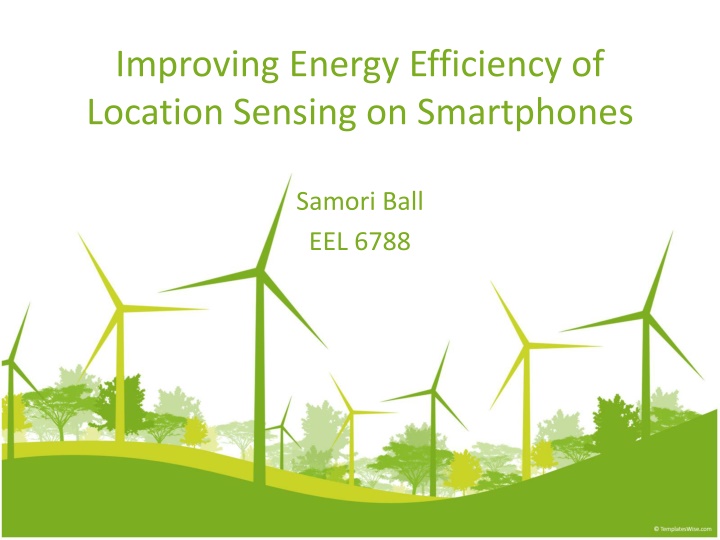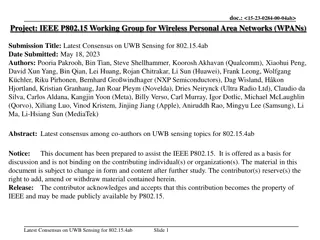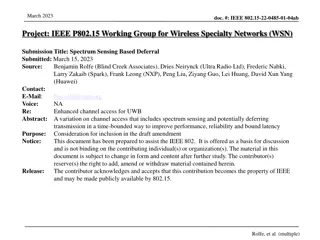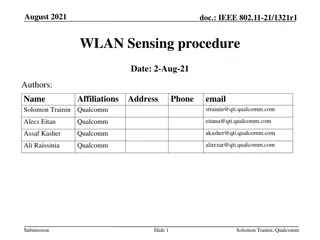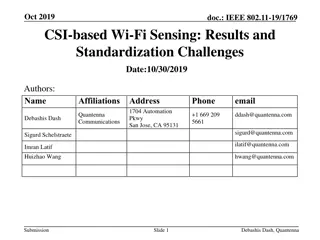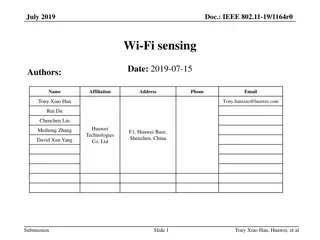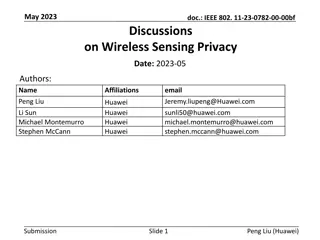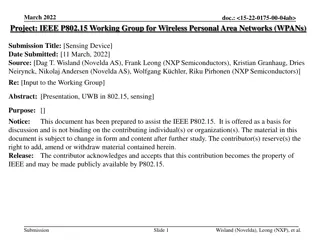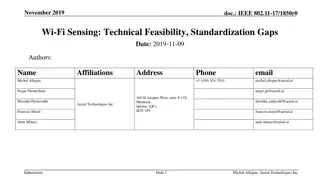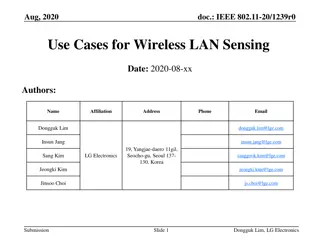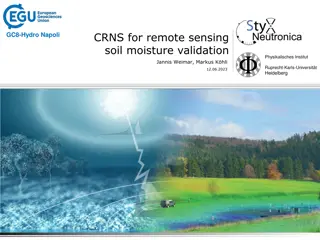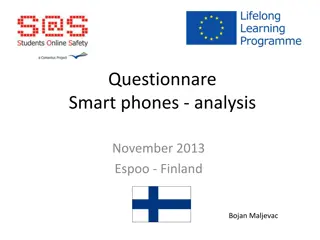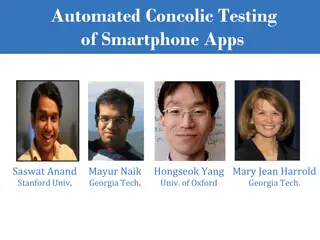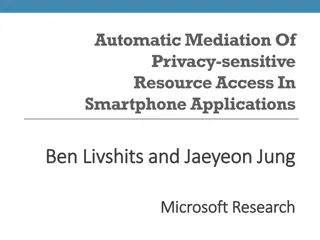Enhancing Smartphone Location Sensing Efficiency
This study delves into optimizing energy consumption in smartphone location sensing mechanisms like GPS and Network Based Triangulation. Comparisons of battery drainage rates with and without GPS provide insights. Additionally, the energy efficiency of Network Based Triangulation as a less accurate but more energy-saving alternative to GPS is discussed. Strategies for reducing energy consumption in sensing applications, such as Sensing Substitution, Sensing Suppression, Sensing Piggybacking, and Sensing Adaptation, are explored within the context of system architecture.
Download Presentation

Please find below an Image/Link to download the presentation.
The content on the website is provided AS IS for your information and personal use only. It may not be sold, licensed, or shared on other websites without obtaining consent from the author.If you encounter any issues during the download, it is possible that the publisher has removed the file from their server.
You are allowed to download the files provided on this website for personal or commercial use, subject to the condition that they are used lawfully. All files are the property of their respective owners.
The content on the website is provided AS IS for your information and personal use only. It may not be sold, licensed, or shared on other websites without obtaining consent from the author.
E N D
Presentation Transcript
Improving Energy Efficiency of Location Sensing on Smartphones Samori Ball EEL 6788
Smartphone Energy Consumption Location may be the largest energy hog in sensing applications Most smartphones have two location sensing mechanisms GPS Network Based Triangulation (Net)
GPS Energy Consumption Test Without GPS a cellphone battery level drops to 94% in an hour With GPS turned on a cellphone battery level drops to 79% in an hour
Network Based Triangulation(NET) Collects information about reachable cell towers (or WiFi access points) to determine location by retrieving a location database Uses less energy than GPS Causes a cellphone battery level to drop to 93% in 1 hour Less accurate than GPS
GPS vs Net GPS can achieve accuracy up to 10m Net achieves accuracy of about 30m to 100m Net can be more accurate under certain circumstances Net or GPS can be unavailable in different areas
Reducing Energy Consumption Test was done on an android phone For most sensing applications energy management comes down to GPS usage management Most sensing applications don t manage their energy usage well No applications coordinate with other applications to manage GPS usage
Reducing Energy Consumption Sensing Substitution (SS) Sensing Suppression (SR) Sensing Piggybacking (SP) Sensing Adaptation (SA)
Sensing Substitution Android phones allow applications to register which location sensing mechanism they want to use when they register their locations There is no way to swich mechanisms on the fly as conditions change
Sensing Substitution This project uses SS to serve as a middleman to do dynamic selection of mechanisms It creates a profile of the areas a user travels through and substitutes the optimal mechanism depending on the profile
Sensing Substitution A mechanism is optimal if it meets the accuracy requrements and uses less energy When GPS is needed but unavailable Net can be sustituted When only Net accuracy is needed and Net is unavailable GPS will be substituted with reduced update frequency
Sensing Suppression An application calls the location mechanism even when the user stays in one place for an extended period of time SS uses the lower powered accelerometer and orientation sensors to determine the state of mobility If the mobility state is determined to be static use of the location sensing is supressed
Sensing Suppression Supression is dependant on application requirements If an application has coarse location needs supression occurs more readily The location mechanism is called periodically even in suppressed mode to validate the state Users are allowed to manually adjust the state States are determined with confidence levels that use profiled route information
Sensing Piggybacking Applications don t syncronize their requests for the location mechanism Sensing Piggybacking coordinates the requests of multiple applications to make the least amount of calls to the location mechanisms possible
Sensing Piggybacking For example,If there are two applications that register to use a location mechanism 1 with a 1 minute interval and another with a 2 minute interval the use at 1 minute intervals is used to satisfy the 2 minute interval need
Sensing Piggybacking GPS and Net requests are considered separately, but If there are no other Net requests, a GPS request can be substituted
Sensing Adaptation When the battery is running low users may accept lower accuracy in a trade off for longer phone use time SA adjusts the intervals of calling the GPS when the battery is low The user has the ability to manually input the desired application degrees
Sensing Adaptation A threshold e.g. 20% is set by the user below which SA kicks in SA adjusts the intervals of calling the GPS when the battery is low The user has the ability to manually input the desired application degrees
Integrated Operation At time T0 user is initially in motion and the battery level is high, SS begins to work At T1, SP becomes operational When the user becomes static, SR kicks in When the battery level becomes low,SA comes into play As the user starts moving again, SR stops, and SS is invoked if possible
Mobility Profiling Both SR and SS use the M-Area structure M-Area is an area, generated by profiling, that has a particular characteristic of GPS and Net Each area is a rectangle with 3 properties: Boundary-start, end, width Usage-number of visits, last visit time Sensing charistics-availability and accuracy of GPS and Net
Mobility Profiling SR and SS change states as a user moves from one M-Area to another There is a tradeoff with M-Area Size Larger M-Area, higher Supression probability Smaller M-Area, less storage space and processing time
Results SR Effectively supresses about half of GPS sensing and improves battery life for calls by 400s SP Improved call-making time by up to 650s per hour
Results SA For every hour of running a location sensing application about 20 minutes of phone-call time can be saved SS With a 300-meter accuracy requirement GPS invocations reduced by 50%
Conclusion GPS usage reduced by 98% Improved battery life by up to 75% Android platform was chosen for it s open nature and popularity How much the application can accomplish may depend on OS architecture
Current Work Energy-Efficient Rate-Adaptive GPS-based Positioning for Smartphones Uses bluetooth and accelerometer to help with positioning and minimized GPS use Uses celltower RSS blacklisting to avoid the use of GPS where it is not availabe
Future Work Application-aware tuning of location-sensing parameters Indoor location-sensing (e.g. use of WiFi networks)
References Zhenyun Zhuang1 Kyu-Han Kim2 Jatinder Pal Singh2, 1Georgia Institute of Technology, Atlanta, GA 30332, U.S.A. 2Deutsche Telekom R&D Laboratories USA, Los Altos, CA 94022, U.S.A., zhenyun@cc.gatech.edu, kyu-han.kim@telekom.com, jatinder.singh@telekom.com, Improving Energy Efficiency of Location Sensing on Smartphones Android programming tutorial [Chau Ngo] iPhone programming tutorial [Jonathan Mohlenhoff] Shane B. Eisenman, Emiliano Miluzzo, Nicholas D. Lane, Ronald A. Peterson, Gahng-SeopAhn, and Andrew T. Campbell, "BikeNet: A Mobile Sensing System for Cyclist Experience Mapping", ACM Transactions on Sensor Networks (TOSN), vol. 6, no. 1, December 2009, Bikenet
